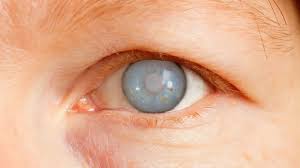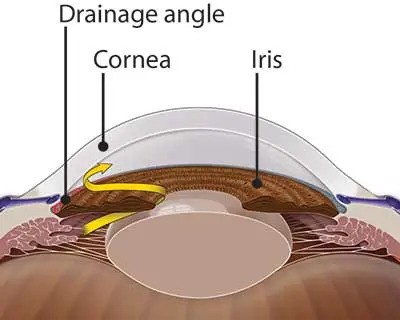
Glaucoma is an eye condition with increased pressure in the inner eye (intraocular pressure, IOP) due to excess fluid buildup that ultimately causes damage to the optic nerve. Glaucoma is one of the leading causes of blindness. It is considered the “silent thief of vision” as it slowly and progressively damages your sight.
There are two major types of glaucoma.
Open-angle glaucoma
This is the most common type of glaucoma. It happens gradually, where the eye does not drain fluid as well as it should (like a clogged drain). As a result, eye pressure builds and starts to damage the optic nerve. This type of glaucoma is painless and causes no vision changes at first.
Some people can have optic nerves that are sensitive to normal eye pressure. This means their risk of getting glaucoma is higher than normal. Regular eye exams are important to find early signs of damage to their optic nerve.
Angle-closure glaucoma (also called “closed-angle glaucoma” or “narrow-angle glaucoma”)
This type happens when someone’s iris is very close to the drainage angle in their eye. The iris can end up blocking the drainage angle. You can think of it like a piece of paper sliding over a sink drain. When the drainage angle gets completely blocked, eye pressure rises very quickly. This is called an acute attack. It is a true eye emergency, and you should call your ophthalmologist right away or you might go blind.
Here are the signs of an acute angle-closure attack:
Many people with angle-closure glaucoma develop it slowly. This is called chronic angle-closure glaucoma. There are no symptoms at first, so they don’t know they have it until the damage is severe or they have an attack.
Angle-closure glaucoma can cause blindness if not treated right away.
Your eye constantly makes aqueous humor. As new aqueous flows into your eye, the same amount should drain out. The fluid drains out through an area called the drainage angle. This process keeps pressure in the eye (called intraocular pressure or IOP) stable. But if the drainage angle is not working properly, fluid builds up. Pressure inside the eye rises, damaging the optic nerve.

There are generally no noticeable symptoms in the early stages of open-angle glaucoma. As the disease progresses, patients develop blind spots in their peripheral (side) vision, and eventually, their central vision is also compromised.
People who develop angle-closure glaucoma have no symptoms either but are struck by an attack of blurred vision with halos, possible headaches or eye pain, nausea, and vomiting.
Risk factors for developing glaucoma include race, age, elevated IOP, female gender, nearsightedness, and hereditary.
The best way to diagnose glaucoma is to get an annual comprehensive eye exam. Your eye doctor will measure your eye pressure, examine your optic nerve, test your central and peripheral vision, and more to detect changes in your eyes or sight that might indicate early-stage glaucoma.
Unfortunately, there is no cure for glaucoma. However, medication or surgery can slow its progression and help prevent further vision loss.
The proper treatment will depend on the type of glaucoma, progression, and other factors. It may include eye drops, medication, laser surgery, incisional surgery, and other minimally invasive glaucoma surgeries (MIGS). Surgery is done to create a new drainage system for the eye to allow the eye pressure fluid to release.
SLT is advanced laser surgery to manage patients with open-angle glaucoma. This laser eye treatment selectively stimulates or changes only specific pigmented cells to activate increased fluid drainage and may reduce the need for lifelong use of eye drops and other medications.
Click to Watch Video